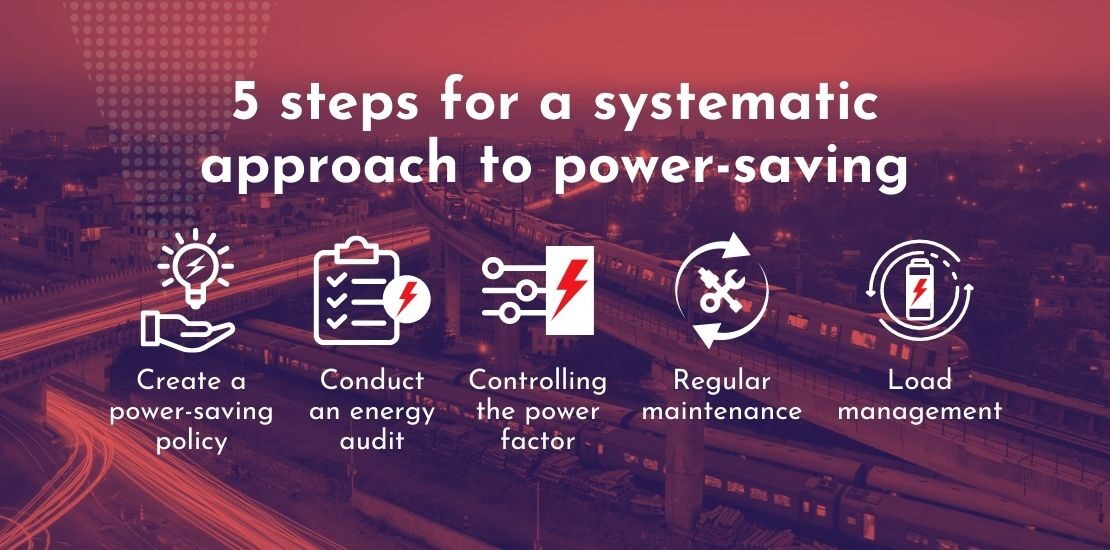- December 22, 2021
- Posted by: Dyaneshwar Nirmale
- Category: Digital Meters

Power-saving is a necessity for every production facility, regardless of the industry it serves. With systematic power-saving, manufacturing facilities can save crores of rupees while the utility companies can meet their power demands without any issues. That said, there is more to power saving than just switching to efficient lighting or switching off air conditions and other machines when not needed.
Efficient monitoring of energy use, and a data-driven energy-saving policy enables manufacturing facilities to build a more systematic and effective approach to power-saving.
Consider these 5 steps to build a systematic framework for power-saving at your facility
Create a power-saving policy
The energy-saving policy is a document that defines the strategies and steps to be taken for power-saving.
ISO 50001 is a notable standard in energy management. It lays down the following measures for efficient management of energy
- Set specific power-saving targets and objectives
- Study power usage data for better understanding and decision-making
- Measure the results
- Draft an energy-saving policy
- Periodically improve and update the policy
A policy-based approach to power-saving enables industrial facilities to gather power-usage data and instruct specific computers to control, hibernate, or shut down certain systems to save power.
Conduct an energy audit
An energy audit helps identify the root cause behind power losses at the facility, and the areas that consume the most amount of power. Using the audit information, the consumer could decide the measures required to reduce power consumption without impacting the regular production cycle.
The consumer could choose a quick or a detailed energy audit
Walkthrough energy audit
A walkthrough audit analyzes factors such as the power consumption and working of major loads, and human elements such as the number of staff, shifts and timings. The result of this audit will suggest measures such as shifting to CFL lights or reducing the number of switches per luminary. Explore such basic power-saving tips on our blog here
Detailed audit
The detailed audit focuses on the collection of power usage data, analysis of bills, and identifying all major or minor loads that increase power consumption. Results from the detailed audit lead to measures such as steps to control the power factor, and the potential of retrofits to save power.
Detailed audit helps the consumer understand whether retrofitting works or should the machines be replaced with new ones for better power efficiency.
Read more about data analysis in power saving on our blog here
Controlling the power factor
Power factor is the ratio of active power to reactive power. In recent years, the power factor has become important for billing as many states in India have implemented KvAh billing. Power factor should be maintained close to unity. Many loads such as motors in a facility tend to be inductive. They need reactive power to start operations.
An increase in reactive power lowers the power factor. KvAh billing charges the consumer for apparent power instead of covering active power and then leaving power factor penalties separately. Thus, the reactive power and power factor are also being billed directly in one go.
The consumer must reduce the reactive power and maintain a unity power factor. This will in turn improve the voltage profile of the electrical system, reduce power losses, and provide more stable power.
Regular maintenance
Proper maintenance of loads in the facility helps curb power losses and avoid equipment failure. For example, motors often fail due to voltage imbalance. Monitoring the voltage and mitigating this problem could prolong the life of the motors. Similarly, motors operating in rugged environments need to be protected and maintained to keep up their efficiency and utilize their entire service life.
Regular maintenance of machinery is a simple tool that could have a deep impact on power saving
Load management
The demand for power in a facility is not always the same. Changes in shifts, high and low production cycles keep the demand moving up and down. In such circumstances, load management could be the key to power saving. Smart grid can be a useful advanced system to use for load management
In smart grid operations, the supply from certain loads automatically cuts off when it reaches a certain level of power consumption. Elsewhere, researchers are looking into possibilities where excess power at one place could be diverted to the places where there is a shortage, thus providing balanced power everywhere.
Smart grid brings automation and higher efficiency to power saving within a facility
